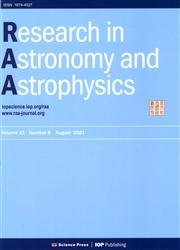修正二阶光谱的污染:改进混响映射运动中的h - α测量
IF 2.8
4区 物理与天体物理
Q3 ASTRONOMY & ASTROPHYSICS
引用次数: 0
摘要
对活动星系核(agn)的长期光谱监测活动提供了丰富的关于其内部结构和运动学的信息。然而,许多观测结果受到二阶光谱(SOS)的污染,这将在光谱的红侧引入一些不确定度。在本文中,我们测试了SOS的效果,并提出了一种利用同时观测的比较星在时域光谱数据中对其进行校正的方法。基于丽江2.4米望远镜观测到的NGC 5548 2019年的混响映射(RM)数据,我们发现科学天体、比较星和分光光度标准星可以共同引入高达30%的Grism 14的SOS。这种不规则但光滑的SOS对发射线的通量密度和轮廓有显著影响,而对光曲线的影响很小。将该方法应用于各个光谱后,我们发现SOS可以有效地校正。修正后的光谱与本征光谱的偏差约为2%,SOS对时间滞后的影响很小。该方法使从档案资料中获得Hα RM测量值成为可能。本文章由计算机程序翻译,如有差异,请以英文原文为准。
Correcting the Contamination of Second-order Spectra: Improving Hα Measurements in Reverberation Mapping Campaigns
Abstract Long-term spectroscopic monitoring campaigns on active galactic nuclei (AGNs) provide a wealth of information about its interior structure and kinematics. However, a number of the observations suffer from the contamination of second-order spectra (SOS) which will introduce some undesirable uncertainties at red side of spectra. In this paper, we test the effect of SOS and propose a method to correct it in the time domain spectroscopic data using the simultaneously observed comparison stars. Based on the reverberation mapping (RM) data of NGC 5548 in 2019, one of the most intensively monitored AGNs by Lijiang 2.4-meter telescope, we find that scientific object, comparison star, and spectrophotometric standard star can jointly introduce up to ~30% SOS for Grism 14. This irregular but smooth SOS significantly affects the flux density and profile of emission line, while having little effect on the light curve. After applying our method to each spectrum, we find that the SOS can be corrected effectively. The deviation between corrected and intrinsic spectra is ~2%, and the impact of SOS on time lag is very minor. This method makes it possible to obtain the Hα RM measurements from archival data.
求助全文
通过发布文献求助,成功后即可免费获取论文全文。
去求助
来源期刊

Research in Astronomy and Astrophysics
地学天文-天文与天体物理
CiteScore
3.20
自引率
16.70%
发文量
2599
审稿时长
6.0 months
期刊介绍:
Research in Astronomy and Astrophysics (RAA) is an international journal publishing original research papers and reviews across all branches of astronomy and astrophysics, with a particular interest in the following topics:
-large-scale structure of universe formation and evolution of galaxies-
high-energy and cataclysmic processes in astrophysics-
formation and evolution of stars-
astrogeodynamics-
solar magnetic activity and heliogeospace environments-
dynamics of celestial bodies in the solar system and artificial bodies-
space observation and exploration-
new astronomical techniques and methods
 求助内容:
求助内容: 应助结果提醒方式:
应助结果提醒方式:


